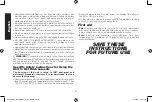
English
9
CONNECTING THE CHARGER
CONNECTION PRECAUTIONS
• Connect and disconnect output clamps only after removing AC Power
Cord from electric outlet.
• Never allow the clamps to touch each other.
• Attach the clamps to the battery and chassis as indicated in the
appropriate section (“Charging a battery installed in a vehicle” or
“Charging a battery that has been removed from a vehicle”).
CHARGING A BATTERY INSTALLED IN A VEHICLE
WARNING
– A spark near the battery may cause an explosion. To
reduce risk of a spark near the battery:
1. Position AC and clamp cords to reduce risk of damage by hood,
door, or moving engine part.
2. Stay clear of fan blades, belts, pulleys, and other parts that can
cause injury to persons.
3. Check polarity of the battery posts. The positive post (marked
POS, P, +) usually has a larger diameter than the negative battery
post (marked NEG, N, –).
4. Determine which post of battery is grounded (connected) to
the chassis. If negative post is grounded to chassis (as in most
vehicles), see 5. If positive post is grounded to the chassis, see 6.
5. For a negative-grounded vehicle, connect the positive (red) clamp
from the battery charger to the positive (POS, P, +) ungrounded
post of battery. Connect the negative (black) clamp to vehicle
chassis or engine block away from battery. Do not connect clip to
carburetor, fuel lines, or sheet-metal body parts. Connect to heavy
gauge metal part of the frame or engine block.
6. For a positive-grounded vehicle, connect the negative (black) clamp
from the battery charger to the negative (NEG, N, –) ungrounded
post of battery. Connect positive (red) clamp to vehicle chassis or
engine block away from battery. Do not connect clip to carburetor,
fuel lines or sheet-metal body parts. Connect to a heavy gauge
metal part of the frame or engine block.
7. See operating instructions for length of charge information.
When disconnecting the charger, disconnect AC cord, remove clip from
vehicle chassis, and then remove clip from battery terminal.
CHARGING A BATTERY THAT HAS BEEN REMOVED FROM A
VEHICLE
WARNING
– A spark near the battery may cause an explosion. To
reduce risk of a spark near the battery:
1. Check polarity of the battery posts. The positive post (marked
POS, P, +) usually has a larger diameter than the negative battery
post (marked NEG, N, –).
2. Attach a 24-inch (minimum length) AWG #6 insulated battery cable
to the negative battery post (marked NEG, N, –).
3. Connect the positive (red) clamp to the positive battery post (red
or marked POS, P, +).
4. Stand as far back from the battery as possible, and do not face
the battery when making final connection.
5. Carefully connect the negative (black) clamp to the free end of the
battery cable connected to the negative terminal.
NOTE:
A marine (boat) battery must be removed and charged on
shore. To charge it on board requires equipment specifically designed
for marine use. This unit is NOT designed for such use.
When disconnecting the charger, always do so in reverse sequence
of connecting procedure and break first connection while as far away
from battery as practical.
DXAEWPC4_ManualENSP_Type2_010920.indd 9
1/9/2020 2:20:29 PM











































